Catalysts: How They Speed Up Chemical Reactions

Catalysts are key players in speeding up chemical reactions in many industries. They are substances that help reactions happen faster without being used up themselves. By lowering the energy needed for a reaction, they make the process more efficient and cheaper.
It’s important to know how catalysts work and their role in different industries. They help make chemical processes better and more sustainable. Catalysts are used in many fields, like oil refining, making ammonia, and producing medicines and green fuels.
In this article, we’ll dive into the world of catalysts. We’ll cover what they are, why they’re important, and the types available. We’ll also look at how they reduce energy needs, their action mechanisms, and their uses in various industries. By the end, you’ll understand how catalysts speed up reactions and their big impact on our daily lives.
Introduction to Catalysts
Definition and Importance of Catalysts
Catalysts are special substances that speed up chemical reactions without changing themselves. They help reactions happen faster by lowering the energy needed. This makes them key in many industries, like making fuels and cleaning the environment.
Their role is huge. They make processes more efficient and green. This is vital for many important tasks.
Types of Catalysts: Heterogeneous, Homogeneous, and Enzymatic
There are three main types of catalysts, each with its own uses:
- Heterogeneous catalysts are solid materials that work with gases or liquids. Metals, metal oxides, and zeolites are examples.
- Homogeneous catalysts mix with the reactants in a liquid solution. Organometallic complexes and enzymes fall into this category.
- Enzymatic catalysts are proteins that speed up biochemical reactions in living things. They are very good at what they do, making them useful in many fields.
Knowing about these different catalysts is crucial. It helps in making chemical processes better. Each type has its own benefits and challenges.
| Catalyst Type | Key Features | Examples |
|---|---|---|
| Heterogeneous | Solid materials interacting with reactants in different phases | Metals, metal oxides, zeolites |
| Homogeneous | Dissolved or dispersed in the same phase as reactants | Organometallic complexes, enzymes |
| Enzymatic | Biological catalysts, typically proteins, in living organisms | Various enzymes found in nature |
Different catalysts help solve various chemical problems. From solids to liquids and proteins, they offer many solutions.
Catalysts and Chemical Reactions
Role of Catalysts in Lowering Activation Energy
Catalysts are key in chemical reactions by reducing the activation energy needed. Activation energy is the energy required to start a reaction. Catalysts offer a path with less energy, speeding up the reaction.
Mechanisms of Catalytic Action
The transition state helps us understand how catalysts work. They stabilize this high-energy state, making it easier for reactants to turn into products. This happens through different ways, like:
- Providing a surface or environment that better aligns the reactants
- Forming temporary chemical bonds with the reactants to facilitate the reaction
- Reducing the energy required to break and form chemical bonds
Knowing these catalyst reaction mechanisms is vital for creating better catalysts. It affects reaction kinetics and the catalyst activation energy needed.
| Mechanism | Description | Impact on Reaction |
|---|---|---|
| Surface Alignment | Catalysts provide a surface that better positions the reactants, facilitating the formation of the transition state. | Lowers the activation energy required for the reaction to occur. |
| Temporary Bonding | Catalysts form temporary chemical bonds with the reactants, creating an intermediate complex that is more easily converted to the products. | Stabilizes the transition state, reducing the activation energy. |
| Bond Breaking/Formation | Catalysts can selectively weaken or strengthen certain chemical bonds, facilitating the breaking and forming of new bonds during the reaction. | Reduces the energy required for the reaction to proceed, lowering the activation energy. |
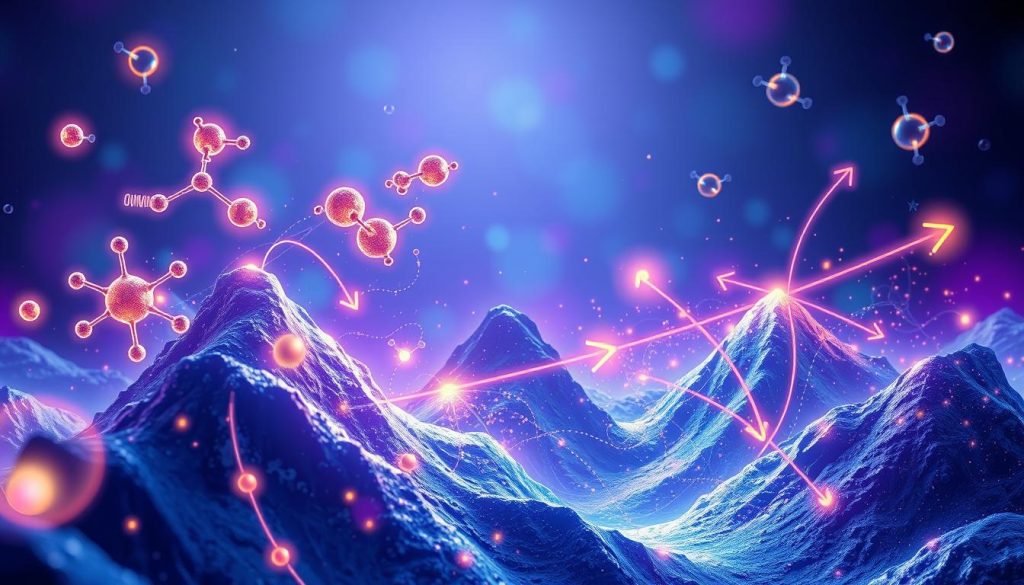
Catalysts in Industrial Processes
Catalysts are key in many industrial processes. They boost efficiency and productivity in various sectors. They are especially important in petroleum refining and making essential chemicals like ammonia and nitric acid.
Petroleum Refining and Catalytic Cracking
In petroleum refining, catalytic cracking is a vital process. It uses catalysts to break down big hydrocarbon molecules into smaller, more useful parts like gasoline and diesel. Zeolites and metal oxides are used as catalysts, making the process more efficient and productive.
These catalysts lower the energy needed for these reactions. This makes it faster to turn crude oil into refined fuels. It also makes the refining process more profitable.
Synthesis of Ammonia and Nitric Acid
Catalysts are also crucial in making ammonia and nitric acid. The Haber-Bosch process uses iron-based catalysts to produce ammonia. This ammonia is key in making fertilizers and other industrial chemicals.
Nitric acid is made from ammonia using platinum-based catalysts. This acid is used to make many chemicals and explosives. It shows how important catalysts are in these important industrial steps.
Overall, catalysts are vital in petroleum refining, ammonia synthesis, and nitric acid production. They make these processes more efficient and productive. By speeding up chemical reactions, they help turn raw materials into valuable products. This makes them essential in today’s industry.
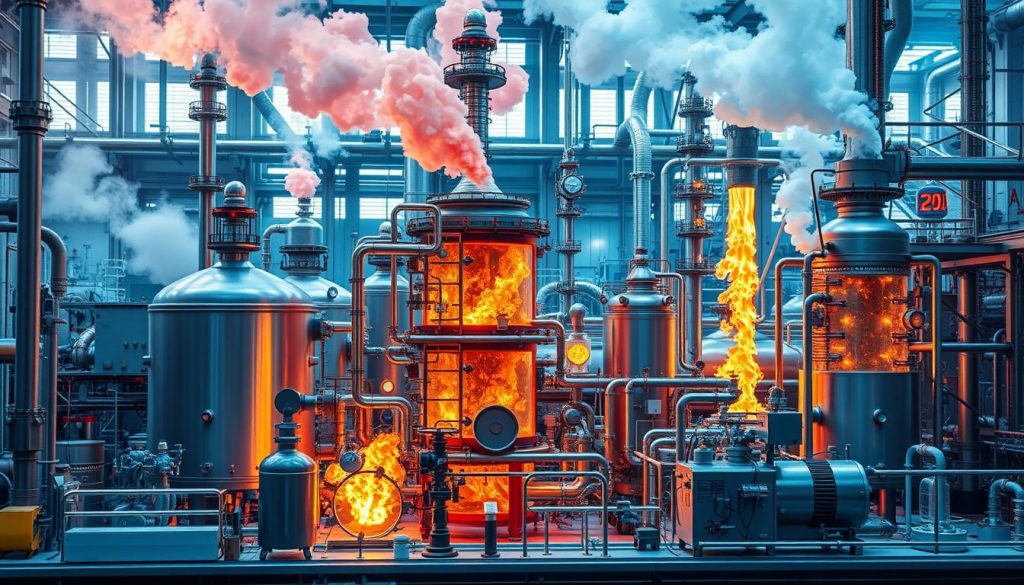
Zeolite Catalysts
Zeolites are amazing materials with a special structure. They are very good at helping chemical reactions in many industries. Their unique properties make them key players in catalysis.
Structure and Properties of Zeolites
Zeolites have a unique, open structure. Their pores are about 0.3 to 1.0 nanometers in size. This lets them act like molecular sieves, picking and choosing molecules based on size and shape.
Their framework includes aluminum, which creates acid sites. These sites are crucial for their strong acid-base properties and high catalytic activity.
Zeolites can be made to fit different needs, like in oil refineries or making petrochemicals. Their flexibility makes them essential in catalysis.
| Property | Description |
|---|---|
| Porous Structure | Zeolites have a three-dimensional, open framework with uniform pore sizes ranging from 0.3 to 1.0 nanometers, allowing them to act as molecular sieves. |
| Acid-Base Properties | The presence of aluminum atoms in the zeolite framework creates acid sites, which give zeolites their strong catalytic activity. |
| Tailored Composition | The structure and chemical composition of zeolites can be customized to target specific catalytic applications, such as fluid catalytic cracking and biomass conversion. |
Zeolite catalysts are unique because of their porous structure, acid-base properties, and ability to be tailored for specific applications. These qualities make them crucial in industrial catalysis.

 The Kinetic Theory of Gases: How Particles Behave
The Kinetic Theory of Gases: How Particles Behave
Nanoparticle Catalysts
Nanoparticle catalysts are getting a lot of attention lately. They have unique properties that make them great for improving how things react. Their small size means they have a lot of surface area, which helps them work better.
These tiny particles can change how they act because of their size. This is called a quantum effect. It makes them even better at being nanocatalysts.
Nanoparticle catalysts can be made from different materials. This includes metals, metal oxides, and semiconductors. Their size, shape, and what they’re made of all matter for how well they work.
Using nanoparticle catalysts could make many industrial processes better. This includes making energy and cleaning up the environment. They could help us find new ways to make things work better and more efficiently.

Nanoparticle catalysts are also good for the environment. For example, nano semiconductors like TiO2 and ZnO can break down harmful chemicals. They do this without making anything else bad.
This shows how these tiny particles can help solve big environmental problems. They can clean up polluted water and soil.
The world of nanotechnology is always growing. Nanoparticle catalysts will be key in making new discoveries. They will help us make things better in many areas, like energy and protecting the environment.
Transition Metal Catalysts
Transition metals and their compounds are key in catalysis. They have unique electronic setups and chemical traits. Their partially filled d-orbitals let them form complex compounds and take part in redox reactions. This makes them very useful as catalysts.
Role of Transition Metals in Catalysis
In catalysis, transition metals can be both homogeneous and heterogeneous catalysts. Homogeneous catalysts, like organometallic complexes, are used in fine chemical and pharmaceutical synthesis. They are chosen for their high selectivity and activity. Heterogeneous catalysts, as supported metal nanoparticles or oxides, are used in many industrial processes. These include petroleum refining, chemical production, and environmental applications.
Applications of Transition Metal Catalysts
Transition metal catalysts are used in many industries. They help in making fuels, chemicals, pharmaceuticals, and cleaning air and water. The ability to adjust their catalytic properties has made them very important in catalysis.
They are used in many processes, such as:
- Petroleum refining and catalytic cracking
- Synthesis of ammonia and nitric acid
- Fine chemical and pharmaceutical synthesis
- Environmental remediation and pollution control
The flexibility of transition metal catalysts makes them crucial in today’s industry and research. They improve the efficiency and selectivity of chemical reactions.
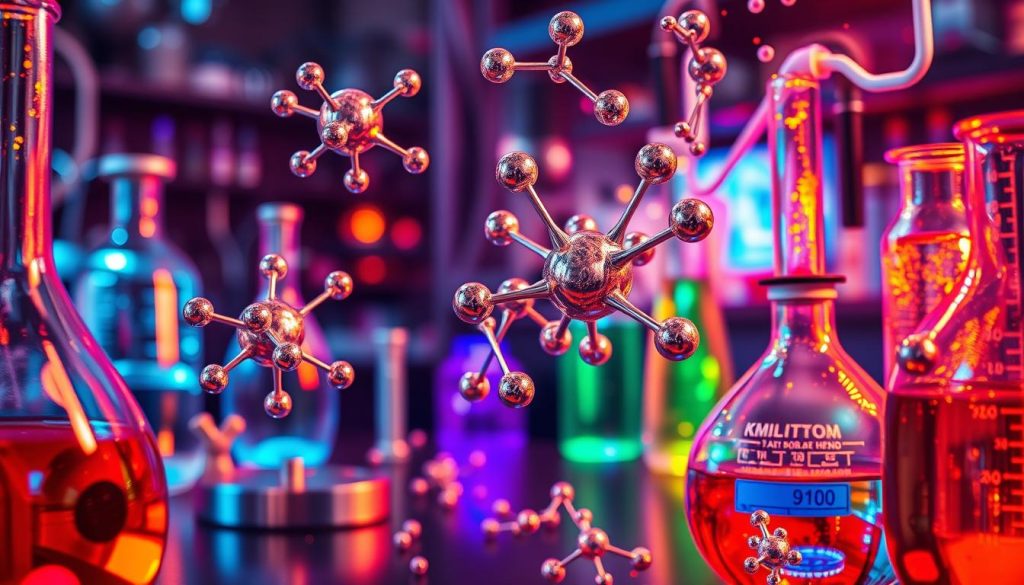
Redox Catalysts
Redox catalysts are key in speeding up chemical reactions. They help transfer electrons between reactants. Often made from transition metals, they’re vital in many industrial and environmental processes.
These catalysts change their oxidation state to help speed up reactions. This makes them crucial for making fuels and chemicals, cleaning wastewater, and reducing air pollution.
Redox catalysts are all about reduction-oxidation reactions. They help move electrons between reactants. By changing their oxidation states, they lower the energy needed for reactions. This speeds up many industrial and environmental processes.
- Redox catalysts often involve transition metals or their compounds, which can undergo reversible reduction and oxidation reactions.
- These catalysts play a crucial role in industries such as fuel and chemical production, wastewater treatment, and air pollution abatement.
- The ability of redox catalysts to facilitate electron transfer makes them essential in the development of sustainable and efficient chemical processes.

Using redox catalysts, we can make chemical reactions more efficient. This reduces energy use and environmental harm. It also opens up new areas in various fields. The work on improving redox catalysts is key to a greener future.
Green Catalysts
Environmental concerns and the need for sustainable development are now key. The focus in catalysis research has moved to green catalysts and eco-friendly processes. Green catalysts aim to reduce waste, boost energy efficiency, and use renewable or recyclable materials.
Environmentally Friendly Catalytic Processes
Green catalysis uses catalysts from natural sources, like enzymes. These biocatalysts are eco-friendly and work well under mild conditions. They are also highly selective and efficient. Also, research focuses on heterogeneous catalysts that can be easily separated and reused.
Biomass Conversion and Renewable Energy
Converting biomass into valuable fuels and chemicals is a key area. Catalysts are vital in turning renewable feedstocks into sustainable alternatives. They also play a key role in renewable energy technologies, like fuel cells and solar energy conversion.
The search for green catalysts and sustainable processes is vital. It helps address environmental challenges and move towards a circular economy. This promotes renewable energy and biomass conversion while reducing the environmental impact of chemical processes.
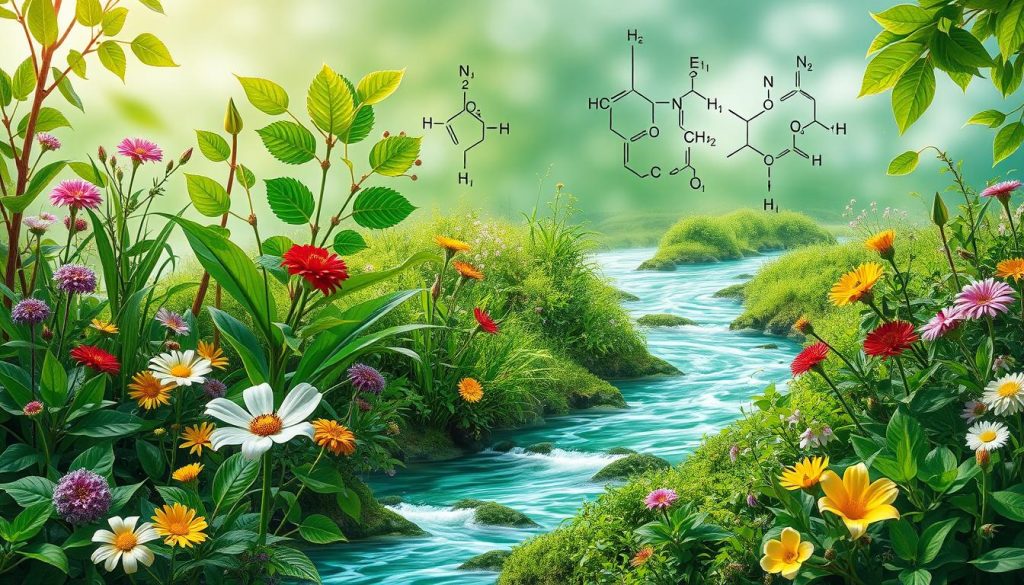
Catalyst Deactivation
Catalysts are key in speeding up chemical reactions. But, they can lose their effectiveness. This loss, known as deactivation, is a big problem in industries. It can make processes less efficient, cost more, and harm the environment. It’s vital to know why and how to stop catalyst deactivation to keep chemical processes running well.
Causes of Catalyst Deactivation
Catalyst deactivation happens in several ways:
 Physical Chemistry: Interaction Between Physics and Chemistry
Physical Chemistry: Interaction Between Physics and Chemistry
- Poisoning: Some chemicals can stick to the catalyst, making it useless.
- Fouling: Deposits like coke can block the catalyst’s surface.
- Sintering: Catalyst particles can stick together, reducing their surface area.
- Thermal degradation: High temperatures can damage the catalyst, reducing its activity.
Strategies for Catalyst Preservation
To fight catalyst deactivation, several methods can be used:
- Proton sponge: Materials that can neutralize acids and prevent poisoning.
- External flow field: A controlled flow of reactants to prevent deposits.
- Self-cleaning cathode: Catalysts that can clean themselves to stay active.
Researchers have found new ways to tackle these issues. For example, the microscopic bubble/precipitate traffic system (MBPTS) by Tang et al. has shown great promise. It helps with surface problems and boosts hydrogen production from seawater.
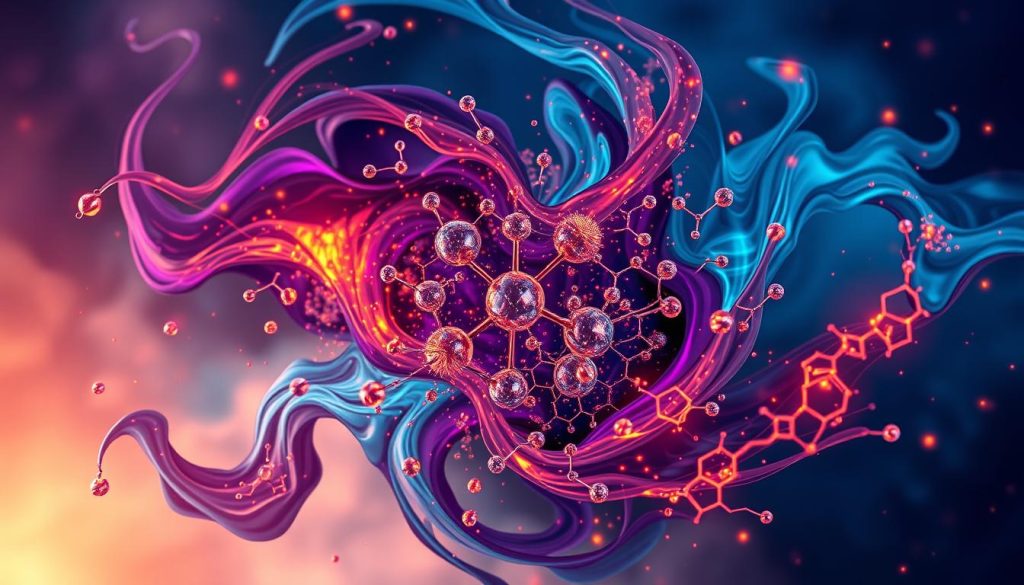
By understanding and tackling catalyst deactivation, industries can keep their processes efficient and green. This leads to better operations and less harm to the environment.
Catalysts and Reaction Kinetics
Catalysts are key in reaction kinetics, which studies how fast and in what way chemical changes happen. They work by lowering the activation energy needed for a reaction to start. Activation energy is the energy needed to start a chemical reaction. Catalysts make it easier by providing a path with less energy needed.
This makes the reaction rate go up. More reactant molecules can now reach the transition state and turn into products.
Influence of Catalysts on Reaction Rates
Transition state theory explains how catalysts help. They make the high-energy transition state easier to reach. This makes it simpler for reactants to get past the energy barrier.
By helping form the transition state, catalysts can make reactions much faster. This makes processes more efficient and cost-effective.
Knowing how catalysts affect reaction kinetics is vital. It helps in designing better catalytic systems. It also helps predict how well catalysts will work in different situations.

| Catalyst Property | Effect on Reaction Kinetics |
|---|---|
| Specific Surface Area | Higher surface area leads to more active sites, increasing reaction rate |
| Pore Structure | Porous catalysts with optimal pore size and distribution enhance mass transfer and accessibility of reactants |
| Active Site Density | More active sites per unit volume or mass of catalyst result in higher catalytic activity |
| Redox Properties | Ability to undergo reduction-oxidation reactions can facilitate certain reaction mechanisms |
Heterogeneous Catalysts
Heterogeneous catalysts are solid materials that work with reactants in gas or liquid form. They are widely used in industry because of their benefits.
Advantages of Heterogeneous Catalysts
- Easy separation and recovery: Solid catalysts can be easily separated from the reaction mixture, enabling their reuse and recycling.
- Stability and durability: Heterogeneous catalysts are generally more stable and resistant to harsh reaction conditions compared to homogeneous catalysts.
- Suitability for continuous processes: Heterogeneous catalysts can be easily integrated into continuous flow reactors, improving process efficiency and scalability.
The surface reactions, mass transfer, and catalyst-reactant interactions are key to heterogeneous catalysts performance. Researchers are always looking for new materials and ways to improve these catalysts. They are essential in many industrial processes.
| Catalyst Property | Impact on Catalytic Performance |
|---|---|
| Surface area | Higher surface area increases the number of active sites, enhancing catalytic activity. |
| Pore structure | Optimized pore size and distribution can improve mass transfer and accessibility of active sites. |
| Acidity/basicity | Surface acidity or basicity affects the adsorption and activation of reactants, influencing selectivity. |
| Redox properties | Redox behavior of the catalyst can facilitate electron transfer during catalytic reactions. |
The recovery and reuse of heterogeneous catalysts is key in industry. It affects the process’s cost and environmental impact.
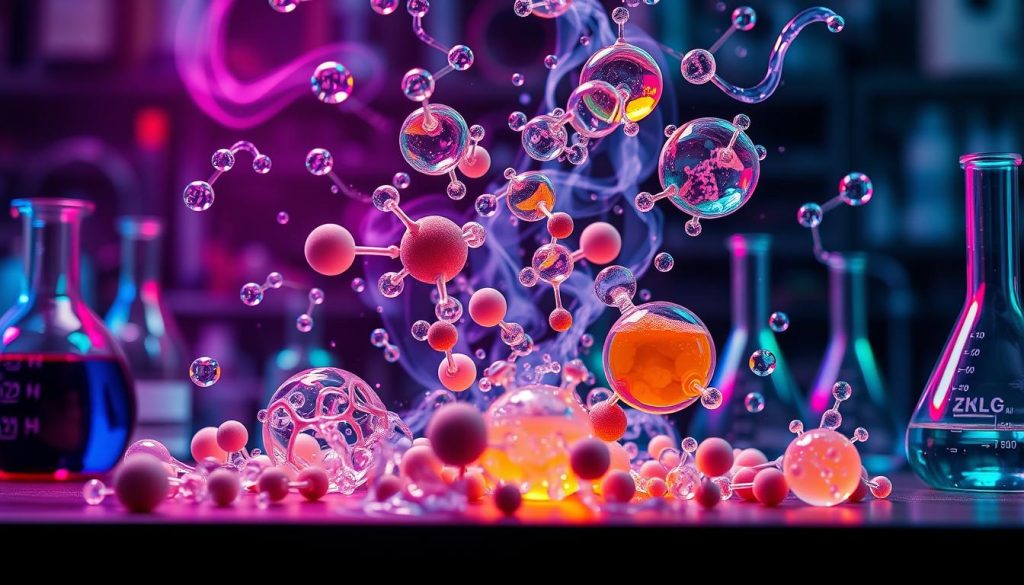
Homogeneous Catalysts
Homogeneous catalysts are dissolved in the same phase as the reactants, usually in a liquid. They are made up of tiny molecules. This makes them different from other catalysts and very useful in many chemical processes.
These catalysts are very active and can pick specific reactions to work on. Organometallic complexes are a type of homogeneous catalyst. They can be made to work on certain reactions very well. This means they can make more of the right product and less of the wrong stuff.
Another good thing about them is how well they transfer mass. Since they are in the same phase as the reactants, they can work together better. This makes the chemical reactions happen faster and more efficiently.
It’s also easy to change how these catalysts work. By tweaking their structure, scientists can make them better at certain reactions. This lets them fine-tune chemical processes to be more efficient and green.
In short, homogeneous catalysts are very useful in many solution-phase reactions. They are key in making chemical processes more efficient and sustainable. Their ability to be very active, selective, and adjustable is what makes them so valuable.

Enzymatic Catalysts
Enzymatic catalysts, or enzymes, are amazing biological helpers. They speed up important chemical reactions in life. These proteins are very specific and efficient in changing many chemicals.
Enzymes have special qualities that make them very useful in many fields:
- High catalytic activity: Enzymes make chemical reactions much faster than without them.
- Substrate specificity: They can only work with certain chemicals, making them very precise.
- Mild reaction conditions: Enzymes work well at normal temperatures and pH levels, avoiding harsh conditions.
- Biodegradability and sustainability: Being naturally made, they break down easily and are eco-friendly.
Because of their versatility and efficiency, enzymes are used in many areas. This includes industrial biotechnology, biochemical reactions, and biocatalysts. As we learn more about enzymes, their role in making chemical processes greener becomes clearer.
| Enzymatic Catalyst | Application | Industry |
|---|---|---|
| Amylase | Starch processing | Food and Beverage |
| Lipase | Detergent formulation | Household and Personal Care |
| Cellulase | Biofuel production | Renewable Energy |

Future Trends in Catalysis Research
The field of catalysis research is always changing. Researchers are looking into new areas to solve big challenges. They are using nanotechnology, computational catalysis, and green chemistry to innovate.
There’s a big need for better and greener catalysts. Scientists are working on making nanoparticle catalysts. These new catalysts could change how we make things, making it more sustainable and cheaper.
 The Periodic Table: Structure, History, and Elements
The Periodic Table: Structure, History, and Elements
Computational catalysis is also becoming more important. It uses powerful computers to study how catalysts work. This helps scientists design better catalysts. It’s a big step towards making chemical processes more sustainable.






